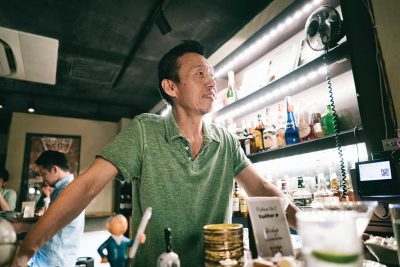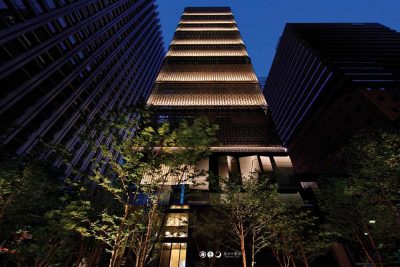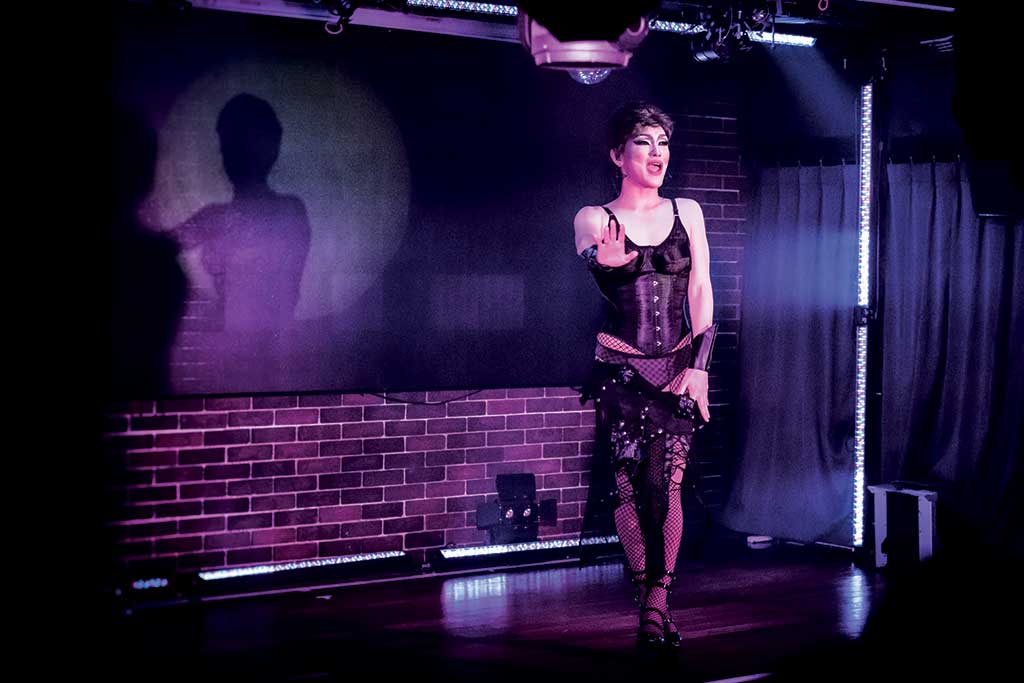Saturday evening, we stayed out late. There was a noticeable drop in crowds around midnight to catch the last trains. Most people don’t live near Shinjuku, so anyone who stays past midnight is essentially committing themselves to party until the trains reopen around 5 A.M. My favorite place that evening was AiSOTOPE Lounge. Takaki, AiSOTOPE’s owner, told us that he’d been hosting gay parties in Tokyo for over 30 years. As he received requests to host bigger and bigger parties, he opened a place of his own. “Of course foreigners are welcome here,” Takaki joked with us when we told him that some of the Japanese bars and clubs we visited weren’t the most welcoming to Americans. “If you can’t speak Japanese here, just speak with body language.” He demoswayed his hips and invited us in to watch the drag performance and meet the queens. My favorite performer showed off her beer-belly with a two-piece bikini and poofy blond pigtails. Her baritone crass made me laugh even though I couldn’t understand a word she was saying. I walked outside for a breath of fresh air to find our photographer Cassidy snapping photos of another drag queen voguing down the fluorescent-lit alley. As we left, a gaggle of college boys giggled as one of them asked me for my number. “For my friend,” he said, pointing to another boy, who blushed.

Yoshi, Owner of Uncle Uncool
In the mornings, jet lag woke us early. As we left to explore the city, we found ourselves caught in morning rush hour, squeezing onto a subway system where daily ridership nears 44 million. Even when crammed side by side, people were polite, quiet, and composed.
We headed south of the city to escape the throng. Our tour guides had warned us that the Jiyugaoka neighborhood would be a “boring place for wealthy housewives.” We were sold. I wanted to buy homegoods, and Cassidy wanted to take photos of Shiba Inus. In this new world of big hats and summer dresses, we found rows and rows of consumer goods shops. If you like the Muji store in New York, here it’s on steroids; you can find a container made from just about every material in any size.

Mitzuaki, Owner of Bridge

(L to R) Nao and Yuta (Owner of Eagle Tokyo)


Sky Gallery Lounge Levita at the Prince Gallery Tokyo Kioicho

HOSHINOYA Tokyo Exterior

HOSHINOYA Tokyo Accommodations
While chasing Shiba Inus, we stumbled upon a kitschy fake Venetian square called La Vita. Couples took turns taking photos of each other on the “bridge.” We broke out in laughter when, after our turn taking cutesy photos on the bridge, we saw that the designer of this gaudy place had even included a little doghouse in the “canal.” One of our many dumbfounded “but why?” moments in Tokyo.
Heading back to the train station, we stopped at a tasteful teahouse called Kosoan. We took our shoes off at the entrance and sat cross-legged on tatami mats drinking tea (they also do sweet iced matcha), looking wistfully out onto their immaculately landscaped courtyard garden.
Refreshed, we headed to the Nezu Museum, which re-opened in 2009 after a three-year renovation. The architect Kengo Kuma’s philosophy is to “recover the place,” and to “frame nature.” He achieves this at the Nezu Museum by integrating elements of glass and bamboo. Items inside the museum’s collection date as far back as the 13th century B.C.E., and include particularly beautiful textiles from the Edo Period. What I most appreciated about this museum was the thoughtful attention placed on both natural and artificial lighting to highlight the objects on display.
For even more aesthetic stimulation, we caught the sunset at the Aoyama Cemetery. This 263,564-square-meter cemetery sits at the heart of one of the busiest and most expensive plots of real estate in Tokyo. Lined with cherry blossoms, the cemetery is crowded during hanami (flower viewing season). When we visited though, it was eerily empty, with only the occasional jogger panting by. Cats rustled through the overgrowth, scaring us as we tried to make visual sense of the outré juxtapositions between the traditional family tombs and the giant skyscrapers surrounding the cemetery on all sides.
Heading to the subway station, we walked along alleys of tall ginkgo trees, passing a young couple sitting atop a pink Ferrari. Following the recommendation of one of my Japanese girlfriends who works in fashion in LA, I turned down one of the Aoyama alleys for a quick bite at Revive Kitchen THREE Aoyama. Located in a plaza that could easily be confused for Manhattan, I waited in line alongside skinny Japanese women for my komatsuna detox smoothie. Komatsuna is a Japanese mustard spinach, with a subtle spicy kick.
That night, we checked into a new hotel, The Prince Gallery Tokyo Kioicho. When the doors to their 36th-floor sky lobby opened I found myself in sensory overdrive. The house scent, an exquisite concoction of Hinoki cypress oil, was like nothing I had smelled before. A DJ played at the hotel’s Sky Gallery Lounge, in front of giant glass windows that looked down onto the glistening city.
After a night of excellent sleep (all rooms at Prince Gallery are installed with iRiS software, so that you can control artificial lighting and completely block out any natural light with a touch of a bedside button), I headed to the gym for a workout and swim. The Prince Gallery gym is one of the largest I’ve seen in this tight and compact city. They also have a pool with real lanes. I forgot a swimming cap and had to buy one to be allowed into the pool. Like most things in Tokyo, the pool water felt fresher and cleaner than what I’m used to in the US, no doubt in part because hygiene rules are taken more seriously. One moment I remember taking my goggles off for a pause to find three people standing around the pool to make sure that everyone was wearing swim caps and had showered before they entered the pool.
Afterward, I took off my swim trunks and took a soak in Prince Gallery’s spa and sauna. In the middle of the day, the two pools (one hot, one cold) and the dry sauna were all empty. I rotated between the different temperatures until my body felt so unwound that all I could do was go back to my room and layed on my window-side day bed, looking at the tiny cars below driving by. The views from Prince Gallery are just spectacular. The hotel is built along a lake that used to be part of the moat for Edo Castle, sandwiched between the Akasaka Palace (where the Prince lives) and the Imperial Palace (where the Emperor lives). To catch summer fireworks in July and August, and for views of Mount Fuji on clear days, book a west-facing room. For views of the Imperial Palace, book an east-facing room.

YONA YONA BEER WORKS
Eventually, Cassidy and I built up enough momentum to head downstairs for a coffee at “Akasaka Prince,” the hotel’s wedding and events venue. Once used as one of the imperial family homes, it was renovated in the 1930s. Its wood is old and creaky, contrasting with the tall steel skyscrapers beside it. As we watched businessmen and women negotiate deals over lunch, I dreamed about what excuses I could make up to host a celebration with my friends here.
Over the next few days, we met with LGBT rights activists to get a better sense of what it’s like to be LGBT in Tokyo. On paper, Japan’s LGBT public policies give little to applaud. There are currently no anti-discrimination laws in employment or in the provision of goods and services. Though we did not experience any outright discrimination ourselves, the law suggests that businesses may legally turn away people for being LGBT. Same-sex marriage is not legal in Japan, though two districts in Tokyo, Shibuya and Setagaya, issue ceremonial certificates recognizing same-sex unions.


